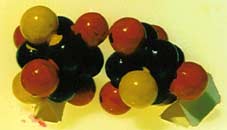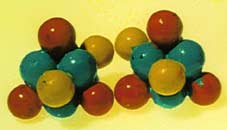by, Sithamalli K. Balasubramanian - Ph.D.

Fig.10a - Edge sharing or van’t Hoff double bond.

Fig.10b - Tetrahedral
double
bond.
The Double Bond; Classical and Tetrahedral:
The classical double bond, herein called the van’t Hoff double bond, involves edge sharing tetrahedra (10a). The reduction in the C=C bond length is explained by our model in a qualitative manner. Quantitatively the bond length arrived at from geometrical considerations {bond length = 2cos (109º 28’/ 2)} is much less than the reported bond length. The angular overlap of bonds may necessitate the increase in the bond length for maximum efficiency. The extent to which this effect operates is difficult to quantify at this stage. The H-C-H bond angle in our model is the same as the tetrahedral bond angle but different from that demanded by the Quantum theory for the double bond, namely 120º. The observed C-H distance is also less than for ethane though there is no reason for such a reduction. The International Union of Crystallographers has accepted the H-C-H angle to be 109º as predicted by our model. In our model the atom is invariant in size and shape. To speak of different atomic radii in different contexts may be a convenient way of comprehending the situation but not necessarily the correct one.
More significantly, our model shows the possibility of a second type of double bond formed by the overlap of b-b, q-q- bonds as shown in photo (10b). This is called the b-b, q-q double bond or the tetrahedral double bond because the ethylenic carbons retain their tetrahedral geometry. The bond is some 15% shorter than the C-C single bond or about 131 pm in length. In contrast to the van’t Hoff double bond the tetrahedral double bond shows flexibility about the central plane. The tetrahedral double bond would be of lower stability than the van’t Hoff double bond.
The new double bond provides a simple explanation of the varied geometry of the cyclopropene system and for the formation and properties of the olefinic complex, the Zeisse’s salt. In both cases the current theory does not resolve the structural and chemical paradoxes posed by these systems. ...top
Cyclopropene: The classical double bond would make cyclopropene a very strained compound. Model (11) shows cyclopropene built with a b-b, q-q double bond. The system is free from any strains, the distances between the atoms are normal and the olefinic carbons could be easily bridged by a single carbon atom. The higher reactivity of cyclopropene as compared with ethylene is due to the higher energy double bond. The predicted bond length, 131pm , agrees well with the observed value (128-130 pm) {ref.15}.

Fig.11 - Cyclopropene.
The model shows that the system could display three types of molecular geometry for the olefinic substituents. The first is the planar mode in which the methylene group and the substituents on the olefinic carbons are in the same plane. Benzocyclopropene (13) belongs to this type {ref.16}. The planarity is the result of the average position of the methylene group during aromatic stabilization of the benzene ring. This point would be more fully described under aromaticity. Contrary to the predictions of the quantum theory, this compound is stable {ref.17}. The junctional C=C bond length in the terphenyl derivative (14) is 133.3pm nearly the same as in the parent cyclopropene {ref.18}. The corresponding value for terphenyl is 140.7pm {ref.19}. The value predicted for benzocyclopropene (12) by the CNDO-2 method {ref.20,21} is 142pm. Our model permits localization of the double bond at the junction without affecting its aromatic stabilization and hence is in agreement with the observed bond lengths. Our model also predicts qualitatively the bond angle distortions at the junction:
C1 C2 C3 =126.3º - and - C3 C4 C5 =109.6º
The second bonding mode for cyclopropene is the basal tetrahedral mode exemplified by the compound (15) {ref.22}. The model predicts an acute angle between the cyclopropene and the six membered ring. This indeed is the case.

Fig. 12 - Fig. 13